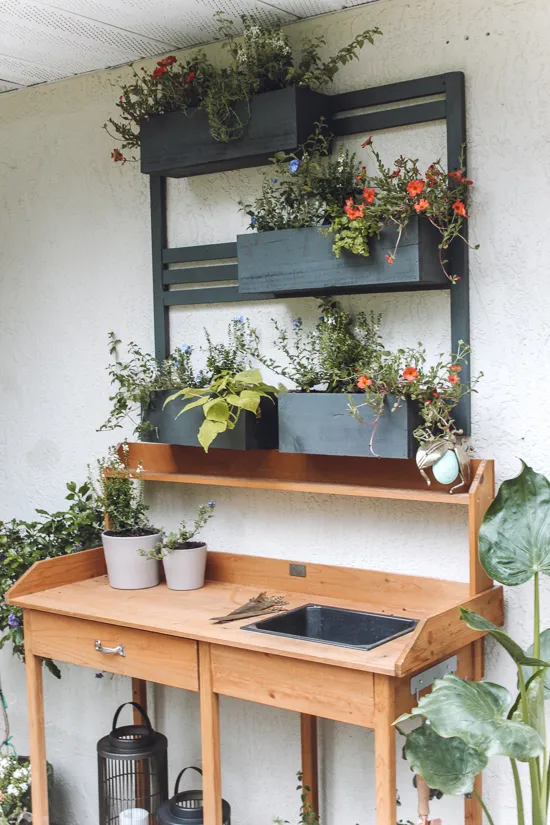Blog
Building a Stunning DIY Vertical Garden for Your Fence

Hey there, fellow craft enthusiasts! Robert Kline here, and I’m excited to share a project that’s close to my heart – creating a beautiful and functional vertical garden. If you’re tired of limited gardening space or just want to add a touch of green elegance to your fence, this DIY project is for you.
Why a Vertical Garden?
I’ve always loved the idea of maximizing space while bringing nature closer. A vertical garden not only adds visual interest to a plain fence or wall, but it also provides a perfect solution for growing herbs, flowers, or even small vegetables in a limited area.
Plus, let’s be honest, there’s a special satisfaction that comes from building something with your own two hands!
Gathering Your Supplies
Before we get started, let’s gather our tools and materials. I like to keep things simple and cost-effective:
Materials:
- Wood: I recommend cedar fence boards for their durability and natural beauty. You can use pressure-treated wood as well.
- Galvanized Finishing Nails: These will hold your planter boxes together.
- Screws: We’ll use these to securely attach the mounting brackets.
- Soil: Choose a well-draining potting mix suitable for your chosen plants.
- Plants: Select your favorites! Herbs, succulents, and cascading flowers work particularly well in vertical gardens.
Tools:
- Compound Sliding Mitre Saw: This will help us make precise cuts for our planter boxes.
- Table Saw: We’ll use this to create the mounting brackets.
- Air Nail Gun & Air Compressor: These make assembly quick and easy. (If you don’t have one, a hammer and nails will work too.)
- Level: Essential for ensuring your planters hang straight.
- Tape Measure: Accurate measurements are key to a successful project.
- Drill: For pre-drilling screw holes.
- Clamps (optional): Helpful for holding pieces together while you nail.
Don’t have all the tools? No worries! Most hardware stores offer tool rentals at reasonable rates.
Let’s Get Building!
Step 1: Planning and Measurements
- Visualize: Before you cut any wood, picture your finished vertical garden. How many planter boxes do you want? How long and wide should they be?
- Measure: Using a tape measure, determine the desired length and width of your planter boxes. Keep in mind the dimensions of your fence boards to minimize waste. I found that using the fence board’s width as the depth of the planters simplified the process.
Step 2: Cutting the Wood
Time to break out the saw!
For each planter box:
- Long Pieces: Cut two pieces of equal length for the front and back of the box.
- Short Pieces: Cut two shorter pieces of equal length for the sides of the box.
- Bottom Piece: Cut one long piece slightly shorter than the front and back pieces to allow for the side pieces to fit snugly.
Step 3: Assembling the Planter Boxes
Now that you’ve got your pieces ready, it’s time to put them together.
- Layout: Arrange the cut pieces on a flat surface to form the planter box.
- Secure: Use your air nail gun (or hammer and nails) to attach the sides to the front and back pieces, forming the basic box shape.
- Bottom: Attach the bottom piece to complete the box.
Step 4: Creating the Mounting Brackets
We’ll be using a French cleat system for a secure and easy way to hang your planters. Here’s how:
- Rip the Board: Using a table saw, rip a fence board in half lengthwise. Then, rip each half again lengthwise at a 45-degree angle to create two long, matching cleat pieces.
- Cut to Length: Cut the cleat pieces to a length slightly shorter than your planter boxes.
Step 5: Attaching the Mounting Brackets
- Planter Boxes: Center a mounting bracket on the back of each planter box, approximately one-third of the way down from the top. Secure it using an air nail gun or screws.
- Fence: Determine the desired location for your planter box on the fence. Using a level, attach the mating cleat piece to the fence using screws for maximum stability.
Step 6: Planting Time!
- Test Fit: Carefully hang a planter box onto its cleat on the fence to ensure a snug and secure fit.
- Repeat: Repeat steps 5 and 6 for each planter box.
- Planting: Fill your planters with soil and your chosen plants.
 A wooden vertical garden with flowers
A wooden vertical garden with flowers
Tips and Tricks
- Pre-drill: Pre-drilling holes for your screws can prevent the wood from splitting.
- Finishing Touches: Consider staining or painting your planter boxes to match your outdoor decor.
- Drainage: Ensure proper drainage by drilling small holes in the bottom of each planter box.
- Watering: Water your vertical garden regularly, especially during hot weather.
Conclusion
Congratulations! You’ve now created a stunning DIY vertical garden that will be the envy of your neighborhood. I encourage you to personalize this project with your own creative flair. Experiment with different plants, colors, and arrangements.
Don’t forget to share your creations with me and the rest of the Robert Kline Art community in the comments below! And for more unique handmade gift ideas, browse our collection on the website.
